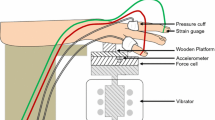Abstract
Objectives
To compare the acute response of finger circulation to continuous and intermittent vibration having the same total duration of vibration exposure and the same energy-equivalent acceleration magnitude.
Methods
Finger blood flow (FBF) was measured in the middle and little fingers of both hands of ten healthy men. Finger skin temperature (FST) was measured in the middle right finger. With a static load of 10 N, the middle finger of the right hand was exposed to 125 Hz at 44 m s−2 root mean square (r.m.s.) in five conditions: (1) 30 min continuous exposure, (2) two periods of 15 min, separated by a 15 min period with no vibration, (3) four periods of 7.5 min, separated by 7.5 min periods with no vibration, (4) eight periods of 3.75 min, separated by 3.75 min periods with no vibration, (5) 16 periods of 1.88 min, separated by 1.88 min periods with no vibration. All five exposures correspond to an 8 h energy-equivalent frequency-weighted acceleration magnitude of 1.4 m s−2 r.m.s. according to International Standard ISO 5349–1 (2001). Finger circulation was measured in all four digits before the application of vibration and at fixed intervals during vibration exposure and during a 45 min recovery period.
Results
The FST did not change during vibration exposure, whereas all vibration conditions produced significant reductions in FBF of the vibrated finger when compared with the pre-exposure FBF. During vibration exposure, the vibration caused a similar degree of vasoconstriction in the vibrated finger without evidence of cumulative effects during intermittent exposure. After the end of exposure to 30 min of continuous vibration there was a progressive decrease in the FBF, whereas there was no statistically significant reduction following exposure to intermittent vibration.
Conclusions
For the vibration stimuli investigated (exposure durations varying from 1.88 min to 30 min, with rest periods varying from 1.88 min to 15 min), the reduction of FBF during exposure was the same for continuous and intermittent vibration. The after effect of vibration was greater following the continuous vibration exposure. Although some evidence from this study is consistent with the notion that intermittent vibration has a less severe effect than continuous vibration, this evidence is not yet conclusive.





Similar content being viewed by others
References
Bovenzi M, Lindsell CJ, Griffin MJ (1998) Duration of acute exposures to vibration and finger circulation. Scand J Work Environ Health 24:130–137
Bovenzi M, Lindsell CJ, Griffin MJ (1999) Magnitude of acute exposures to vibration and finger circulation. Scand J Work Environ Health 25:278–284
Bovenzi M, Lindsell CJ, Griffin MJ (2000) Acute vascular response to the frequency of vibration transmitted to the hand. Occup Environ Med 57:422–430
Bovenzi M, Lindsell CJ, Griffin MJ (2001) Response of finger circulation to energy equivalent combinations of magnitude and duration of vibration. Occup Environ Med 58:185–193
Comité Européen de Normalisation (1996) Mechanical vibration—guide to the health effects of vibration on the human body. CEN Report 12349, Brussels
Czechoslovakian Ministry of Health (1967) Hygiene regulation no 33. Czechoslovakian Ministry of Health, Avicenum, Zdravotnicke Nakladatelstvi, Prague
Diggle PJ, Liang KY, Zeger SL (1994) Analysis of longitudinal data. Oxford Statistical Science Series No 13. Oxford University Press, Oxford
Egan CE, Espie BH, McGrann S, McKenna KM, Allen JA (1996) Acute effects of vibration on peripheral blood flow in healthy subjects. Occup Environ Med 53:663–669
Greenfield ADM, Whitney RJ, Mowbray JF (1963) Methods for the investigation of peripheral blood flow. Br Med Bull 19:101–109
Greenhouse SW, Geisser S (1959) On methods in the analysis of profile data. Psychometrika 24:95–111
Griffin MJ (1990) Handbook of human vibration. Academic Press, London
Hyvärinen J, Pyykkö I, Sundberg S (1973) Vibration frequencies and amplitudes in the etiology of traumatic vasospastic disease. Lancet i:791–794
International Organization for Standardization (2001) Mechanical vibration—measurement and evaluation of human exposure to hand-transmitted vibration. Part 1: General requirements. Geneva, ISO 5349-1
Luo J, Sakakibara H, Zhu S-H, Kondo T, Toyoshima H (2000) Effect of vibration magnitude and repetitive exposure on finger blood flow in healthy subjects. Int Arch Occup Environ Health 73:281–284
The European Parliament and the Council of the European Union (2002) On the minimum health and safety requirements regarding the exposure of workers to the risks arising from physical agents (vibration). Directive 2002/44/EC. Official Journal of the European Communities, 6 July 2002, L177/13-19, Brussels
Welsh CL (1980) The effect of vibration on digital blood flow. Br J Surg 67:708–710
Acknowledgement
This research was supported by the European Commission under the Quality of Life and Management of Living Resources programme—project no. QLK4-2002-02650 (VIBRISKS).
Author information
Authors and Affiliations
Corresponding author
Rights and permissions
About this article
Cite this article
Bovenzi, M., Welsh, A.J.L. & Griffin, M.J. Acute effects of continuous and intermittent vibration on finger circulation. Int Arch Occup Environ Health 77, 255–263 (2004). https://doi.org/10.1007/s00420-004-0507-4
Received:
Accepted:
Published:
Issue Date:
DOI: https://doi.org/10.1007/s00420-004-0507-4




